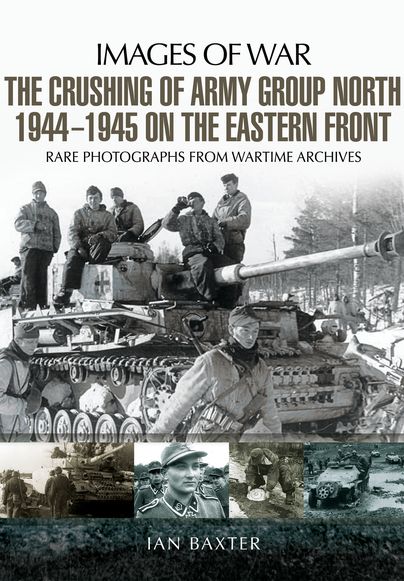| Title: | The Crushing of Army Group North 1944-1945 |
| Author: | Ian Baxter |
| Publisher: | Pen & Sword |
| Published: | 2017 |
| Pages: | 160 |
| LAnguage: | English |
| ISBN: | 9781473862555 |
| Review: | The military history of Heeresgruppe Nord is extensive and possibly also one of the least well known of the German armies in their battle against Russia. Scene of the battlefield is the region around Leningrad, the Baltic States and Prussia. After an initial quick push, the front stabilised late 1941 - mid 1942. Leningrad was besieged, but not conquered. While at first instance the Germans tried to conquer the city, the Russian army counter attacked, which had devastating effects at both sides. It soon turned out that the repositioning of army troops by the German command caused weakening and let to unclarity. The army group repeatedly received changing commanders, each of them with a different outlook on how to conduct war. This situation, combined with the continuing attacks of the Russians, caused the German troops to retreat more often in 1943, although Hitler expressly had given the express command to not move back. The book of Ian Baxter covers the period 1944-1945 in which German command tried to survive the Russian hurricane with all means available. The fights were extremely bloody. Under extreme harsh weather conditions, whole units were completely wiped out, often in man-to-man fights. At that time, Heeresgruppe Nord was a true foreign legion consisting of SS volunteers from many different countries. From a Dutch point of view this is also an interesting army unit, because the vast majority of the Dutch SS volunteers (of the 4.SS-Freiwilligen-Panzer-Grenadier-Brigade ‘Nederland’, the 11. SS-Freiwilligen-Panzergrenadier-Division ‘Nordland’ and the 5. SS-Division ‘Wiking’) were part of this army group. Especially the regiments ‘De Ruyter’ (49th Regiment) and ‘Seyffardt’ (48th Regiment) stood ground very well against the overwhelming Russian flows of attack. Heeresgruppe Nord was eventually forced to retreat to German ground, whilst still fighting, causing many German and Russian casualties. The pictures show the harshness of the landscape, the weather conditions and the attempts of the German army to keep going. In addition, Baxter briefly describes the extreme fights that took place at Narva, Tannenberg, Pillau and Koerland. Baxters’ book is filled with amazing pictures, most of them which have not been published before. At the back of the book, some tables can be found containing the numbers of affiliated army units. |
| Conclusion: | Ian Baxter’s book tells the story of Heeresgruppe Nord not only in words, but also in pictures. The pictures are extraordinary beautiful and clearly show what the circumstances were. It is therefore mainly a picture book, so don’t expect too much in-depth information in writing. Baxter pictures a global overview and that is sufficient to inform the reader. It is a shame, however, that the book doesn’t contain any maps. Some geographical information about the different locations would have been nice. But in the end, this book is yet again a successful contribution by Baxter. |
| Rating: |
Information
- Translated by:
- STIWOT translator
- Article by:
- John Smeets
- Published on:
- 03-09-2017
- Last edit on:
- 04-09-2017
- Feedback?
- Send it!




